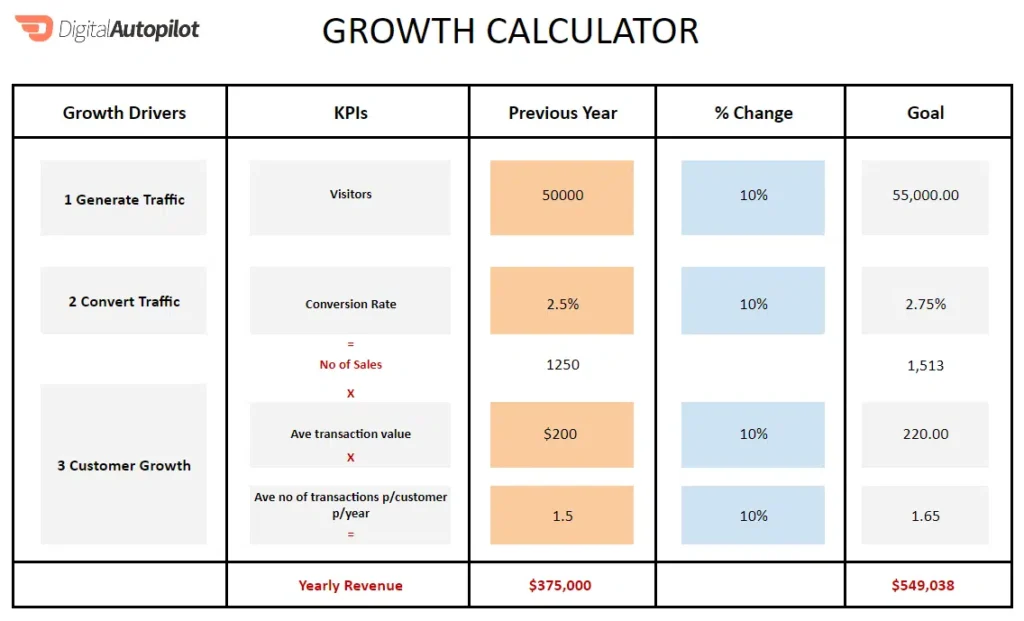
The 3 Drivers of Business Profitability
Welcome to the 3rd episode in our series on Discovery and Focus.
By now, you should have set some growth goals for your ecommerce business and assessed your current reality.
The next step is to work out exactly where to focus your energies to bridge the gap between where you are now and where you want to be. And to do that, we’ll be undertaking what we call a growth potential analysis.
To help you apply that growth potential analysis, we’re going to start by exploring the key factors that drive growth. These are going to underpin your analysis.
Then we’ll look at the five key steps to conducting your own growth potential analysis. Finally, we’ll use that analysis to revise your goals and set your focus going forward. Let’s begin.
Table of Contents
**Templates Mentioned in Video**
Growth Calculator: http://bit.ly/40dUU6r
💰 If you’re interested in learning how to grow your ecommerce business, then sign up for our free Ecommerce Growth Engine video training series here
The 3 Key Factors That Drive Business Growth
To determine where to focus to achieve your growth goals, you need to understand the key factors that drive ecommerce business growth.
When you boil it down, there are three core drivers that underpin revenue growth and they are:
- The amount of traffic you generate. This is measured by the number of visitors that come to your site.
- The amount of traffic you convert as measured by your conversion rate of visitors to sales.
- The value you generate from each customer, which is based on two things: your average transaction value and the number of transactions per customer per year.
Growth in even one of these drivers can significantly increase your revenue. But growth along multiple drivers at the same time, creates a multiplier effect that can revolutionize your business.
This is where the maths comes into your marketing strategy. It’s one thing to drive traffic to your site. That’s important, but it’s not enough. If your site isn’t converting enough of those visitors into paying customers and those customers aren’t generating enough growth and value over time, then you likely won’t achieve your goals and your potential.
To illustrate, let’s say that last year you received 50,000 visitors to your site from Facebook Ads or Google Ads. And let’s say that your site converts at 2.5%. In other words, 2.5% of visitors are becoming paying customers. That gives you 1,250 new customers for the year. Wonderful. Then let’s say that your average customer spends $200 per sale, and they make on average one and a half purchases per year. That would result in total revenue of $375,000 which is what we’ll call your baseline.
But, what if you could increase each of those growth drivers by just 10%? Relatively modest increase right? Let’s look at what happens.
So if you increase your visitors by 10%, you end up with 55,000 visitors. If you increase your conversion rate by 10%, you end up with a 2.75% conversion rate. This gives you, and 1513 customers. If you increase your average transaction value by 10%, you then end up with $220 on average per transaction. And finally, if you increase the number of transactions per customer per year by 10%, you end up with 1.65.
Visitors: 50,000 > 55,000
Conversion Rate: 2.5% > 2.75%
Avg Transaction Value: $200 > $220
Avg Number of Transactions per customer: 1.5 > 1.65
Those increases don’t seem a lot, but when you combine them and look at the total, you’ve now earned over a half-million dollars. An increase of over $174,000 (46.4% increase) from your $375,000 base and that’s just by increasing each of these drivers by 10%.
55,000 visitors x 2.75% conversion rate = 1513 customers per year.
$220 avg transaction value x 1.65 transactions per customer x 1513 customers = $549,037.5
$549,037.5 – $375,000 baseline = an increase of $174,037.5 (46.4% increase)
Now, what does this calculation mean for you and your business in practice?
It means that if you’re looking for growth, you should focus your time, energy, and resources on the growth drivers that need the most help. In my experience, most businesses could do with help in all three of these areas. The Ecommerce Growth Engine course will help you do that, but it may be that there’s one area that sticks out for you. If so, that’s where you should start in terms of your focus.
How to conduct a growth potential analysis for your own business
There are five key steps, but first what you’ll need to do is jump into the growth calculator tab of your growth plan template. That’s where all the action happens.

Your very first task is to set your baseline.
The good news is that you’ve already gathered your baseline data from the past year. (If you haven’t done that yet, click here for the previous episode in this series – Your Current Reality). There’s a formula in the growth calculator that extracts the data from your current reality tab to create your baseline. So this is effectively done for you. Just check to make sure it all looks correct.
Step two is you’re going to need to set your growth percentage. This requires deciding on a realistic but challenging percentage increase for each growth driver for the coming year. You’ll need to estimate this based on your specific situation.
For example, if you are not currently driving traffic to your site, but you do plan to start a paid Google Ads or Facebook campaign then your baseline might be very low and your percentage increase may be quite high.
On the other hand, if your site is already achieving a very high conversion rate, say close to 3%, your percentage increase may be quite minimal when it comes to conversion rate. So you need to apply this to your specific situation.
Once you’ve done that, the third step is to compare your one year revenue target which you recorded on the first tab of your growth plan template. Compare that against the projected revenue goal produced by your growth calculator.
You want to ask yourself, how close or how far are you from this goal?
This will give you an insight into how realistic your goals are. Four, next, it’s time to adjust your numbers.
Consider whether you should adjust your percentage increases to move you closer to your revenue goal, if the numbers aren’t stacking up.
But if so, you got to be careful here. It’s good to be ambitious and I advocate being ambitious, but you also need to be realistic. If hitting your goal requires you to increase your percentage too much, you may need to revise your initial revenue goals on that first tab. That’s what you need to consider here.
And then finally, in step five, based on your analysis, decide which areas need the most urgent focus in your business.
Is it your traffic generation? Is it your site’s conversion rate? Perhaps you can grow the value of your customers by increasing the average transaction value or purchase frequency.
If you’re not sure, you can benchmark against competitors who are already where you need to be. Or look at industry average benchmarks and use that as a guide.
Having this in mind as we move through the Ecommerce Growth Engine course is going to help you make the changes that will have the biggest impact on your business growth.
Your Next Steps
- Set your baseline in the Growth Calculator template
- Set your growth percentage
- Review them against your one year targets
- Adjust your numbers as appropriate
- Decide on your areas of focus to take you from where you are now to your goals.
Good luck! If you have any questions about anything from this episode, send us a message through our contact form.
We really hope you enjoyed this training video. If you did, subscribe to our YouTube channel, like the video and share it with others so they can benefit too.
Access the Full Ecommerce Growth Engine Course for Free
💰 If you’re interested in learning how to grow your eCommerce business, then sign up for our free Ecommerce Growth Engine video training series here: https://bit.ly/3SHfCbj
Need Help?
If you need help finding your target market and building a cohesive marketing strategy, get a no strings attached 30 min digital marketing strategy session here.



